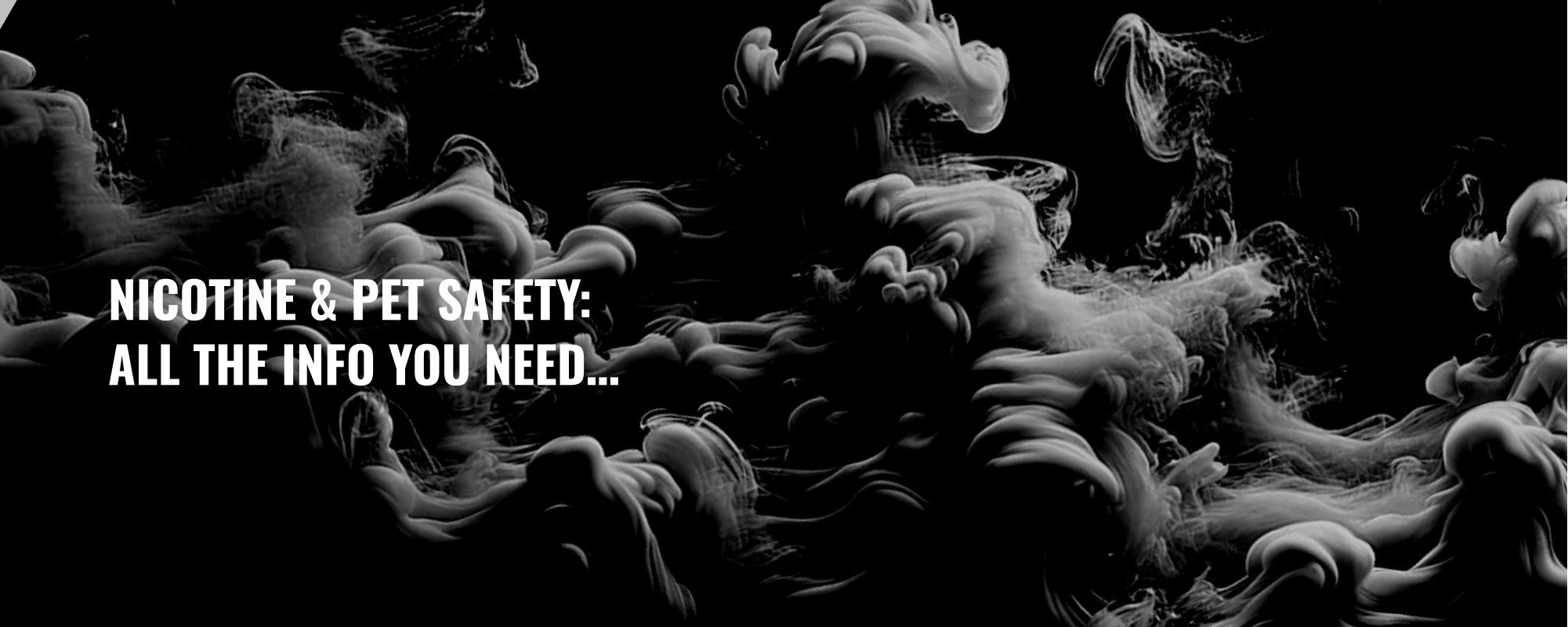Nicotine & Pet Safety:
All The Info You Need…
If you’re like me, your animal companion is apart of your family, and sometimes our habits and addictions can affect our pets in ways we never bothered to think about. For some of us, our addiction to smoking (or any other form of nicotine consumption) can be one of the most dangerous hazards our pets face. From dogs and cats, to guinea pigs, fish, and ferrets we’ll cover the hazards, the effects of nicotine poisoning, and the best ways to keep our furry family members safe!
Hazards/Types of Nicotine
While nicotine may be the main substance that can harm our pets, it’s delivered in many different ways. In this article we will go through most (if not all) of the ways nicotine can be delivered, how they can endanger your pet(s), and the best ways to avoid having your pets come into contact with potential hazards.
Symptoms To Look Out For
As with most cases of poisoning, there are symptoms to look out for. These include, but are not limited to: vomiting, diarrhea, tremors/trembling, drooling/hypersalivation, constricted pupils, frantic or odd behavior, seizures, and unfortunately death (1). Below you will learn about the various forms of nicotine delivery and how they’re harmful to your pet, as well as what you should keep in mind to keep your companion safe if they are to be around these substances. Chewing Tobacco, Snuff, & Snus
Chewing tobacco (and its various forms) can be very harmful to pets, not just because it carries nicotine, but because it can be scented/flavored, making it seem much more palatable. Because of this, your pets can end up consuming quite a bit in a short amount of time, which adds to the danger of nicotine poisoning. Many people think inducing vomiting is the best way to go, but in most situations, it is not, and can carry more risks (but more on that later). For now, the best thing to do, for most of these situations, is to seek professional help from a licensed veterinarian ASAP, or call (888) 426-4435 ASPCA-Animal Poison Control
Shisha/Sheesha Tobacco
Also known as Mu‘assel, Shisha tobacco can be very harmful to your pets. Like some chewing tobacco, shisha tobacco is flavored/scented with a syrupy blend of molasses and vegetable glycerin, which makes it taste sweet. Some flavors can add an extra level of toxicity, like grape. Also, because shisha is syrupy, you have to be careful not to spill or leave spills where your pet can get to it, due to possible consumption. Of course, if you suspect your pet has consumed any at all, please seek help from a vet immediately.
Dissolvable Tobacco
Compared to conventional cigarettes, chewing tobacco, and shisha, dissolvable tobacco is a relatively new form of smokeless tobacco, and can unfortunately be just as, if not more dangerous, than other forms of tobacco. Dissolvable tobacco comes in different strengths, in the form of “pellets”, ranging from 1 milligram of nicotine, to 4+ per pellet. Since the toxic dose of nicotine is ½-1 milligram per pound (for dogs) a small dog wouldn’t need to get ahold of many of these to have a bad fur day… Make sure to always have them in child safe bottles and keep them out of reach.
NRT's (Nicotine Replacement Therapies)
NRT’s covers a wide range of products used to help people quit smoking by curving their nicotine cravings and/or helping with the symptoms of nicotine withdrawal. The NRT’s we’ll cover are Patches, Gum, Nasal/mouth Sprays, Inhalers, and Lozenges. So, let’s go over the patch. The patch can come in different strengths of nicotine, ranging anywhere from 8 – 113 mg of nicotine. Extra care should be taken when storing nicotine patches because of their nicotine strength. It wouldn’t take very many to poison even a rather large dog. Luckily, most NRT’s (besides gum) aren’t flavored or scented, so most pets probably wouldn’t bother with them, but it does still happen, which brings me to the next NRT, gum. Nicotine gum is the highest risk NRT you can have around your pets. Most nicotine gum is flavored and expels a minty aroma. Not to mention it’s usually sweetened with an artificial sweetener known as xylitol, which is incredibly poisonous to dogs. They usually come in 2 mg and 4 mg strengths, meaning even just one piece of nicotine gum can seriously harm (or kill) your pet. Common practice is to leave the gum in a purse or on a kitchen counter, but that can be where most accidents take place. Take extra precautions and be mindful of keeping your gum in a place where your pet can’t gain access. Nasal sprays are another NRT that aren’t flavored or scented, but with how toxic they are, if your pet gets a hold of even a little then it may become a disastrous situation. Usually one dose (one spray) is 1 mg of nicotine, and these sprays can hold 80+ doses. The same can be said about Mouth Sprays, only these ARE flavored and scented, so your pet might be more interested. You should take extra care to keep mouth sprays away from your pets. Nicotine lozenges -- like gum -- can be another dangerous NRT to your pets, mainly because of their nicotine strength, and the fact that they are flavored. They usually come in 2 mg and 4 mg nicotine strengths, and an assortment of flavors. Most come in plastic tubes with easy to open “child safety” screw tops. Please ensure that your containers are secured and not left in an easily reached area. Last but not least, we have Inhalers. Inhalers are the only NRT on this list that are by prescription only. While these usually use cartridges (which you might think is safe) the cartridges are made of thick plastic, and the liquid inside can hold around 10 mg of nicotine. It’s not often pets get ahold of one of these cartridges, but it does happen, so be aware.
Kreteks (Cloves)
Kreteks (also known as clove cigarettes) are cigarettes made with tobacco, cloves, and a slew of other flavors. They are also sprayed with sweetener from time to time, so that can make them extra enticing to your pet. They can also be mixed with certain spices that are harmful to your pets, (mainly nutmeg, as nutmeg is very toxic to dogs). So, make no mistake, even if it seems silly that your pet would eat a whole clove cigarette, it can happen, and if it does, it can be fatal.
Pipe Tobacco/Loose Leaf
Pipe Tobacco (also known as loose leaf tobacco) is somewhat of an enigma when it comes to the nicotine content. Usually pipe tobacco touts that it has less nicotine than conventional cigarettes, however the amount ranges greatly. Some loose leaf tobacco can have very little nicotine, while others can have quite a bit, so the best rule of thumb, as always, is don’t leave it where your pets can find it. Loose leaf tobacco is usually flavored, has a sweet odor, and is kept in bags very easy for say, a dog, to tear open and get into. While I personally can’t see a cat wanting to rip into a bag of pipe tobacco, I can see a dog, ferret, or even guinea pigs getting into it. So, keep your pet safe and out of reach of these products.
Ejuice/Eliquid Vaping
E-juice, E-Liquid, or Vape Juice, is the main component for Vaping. The problem with ejuice and your pets comes from its ingredients. Usually e juice is a blend of vegetable glycerin(VG), propylene glycol(PG), flavoring, and nicotine. Other than the nicotine (which we know is harmful) there’s also the PG, which is harmful to cats, and the flavorings, (which depending on which ones are used, can be toxic). Also, we should take a minute to look at e-juice in its entirety. Besides ejuice coming in an assortment of flavors, it also comes in an assortment of nicotine strengths and ratios of VG to PG. While you might think ejuice with 0 mg of nicotine wouldn’t cause too much of a problem, it can be very poisonous to your cat if it’s a blend that’s heavy on the PG. Now you might ask yourself, “what if I use an all VG blend with no nicotine?”, well, now it comes down to the flavoring being used, because flavors like grape or nutmeg can be very toxic to your dog. Vape liquid should always come in child safety containers, but even child safety caps won’t stop a determined pet. Since most bottles of ejuice are plastic, most pets can puncture it with their teeth. With vaping also comes the dangers that come with your mod, like a leaking tank full of ejuice; or say your dog was chewing on your PV(Personal Vaporizer), and caused a short. It’s safe to say that you should always keep your eliquid and vaping accessories away from your pets at all times. You never know when your pet might take an interest in the thing you’re putting up to your mouth all the time.
Second Hand Smoke/Vapor
Many people don’t think about it but our pets suffer from second hand smoke much in the same way we do (some animals much worse). You have to take into consideration their smaller size, their respiratory system, allergies… there’s a lot of information people should consider before smoking in front of their pets. Dog breeds that already have problems breathing include, but are not limited to, pugs, boxers, chihuahuas, bulldogs, shih tzus, and more. Some might consider vaping a safer choice, but since you’re dealing with chemicals besides nicotine that can cause problems for your pets (like PG and certain flavorings), it probably wouldn’t be a good idea to fill up your living room with vapor clouds. Second hand smoke has even been found to affect fish, with the chemicals from the smoke clinging to the water. Whatever you do, just don’t blow smoke/vapor in your pets face. It’s mean and can have a negative effect on their health.
Thirdhand Smoke/Vapor
First, you might be asking yourself “what the heck is thirdhand smoke?”, and that’s a very good question. Thirdhand smoke is when residual nicotine ends up on surfaces, and since dogs, cats, heck even babies, lick up and put things in their mouth they’re not suppose to, it’s easy for them to fall victim to thirdhand smoke/vapor. One of the biggest culprits of thirdhand smoke comes in form of dogs eating cigarette butts, which can cause all sorts of health issues, from intestinal blockage, to nicotine poisoning, and all sorts of disorders in between. Thirdhand smoke is a relatively new concept, and studies are still being done. Suffice it to say, if you’re going to smoke or vape in your home, try your best to keep all your surfaces clean (including couches, kitchen counters, bathroom floors, etc…) and put your butts in the trash!
Making Your Pet Vomit (don't do it, unless...)
Try to avoid making your pet vomit. There are only a few methods we can use at home to induce vomiting, and all carry some form of risk, some more fatal than others, and in some cases, more fatal than the reason for inducing vomiting. In these situations, only induce vomiting if there is no hope of reaching a vet in time. (2) Conclusion
We hope this article opened some eyes and really helped put into perspective how our nicotine addictions can affect our pets in ways we might not have ever thought about. I know that if I ever found out I hurt my pet, even without realizing or doing it on purpose, it would hurt and devastate me, and I’d like to think I’m not the only one. So, live your lives, be safe, and make sure your habits don’t cause your pets grief.
This entry was posted in Vaping Relevant on October 2, 2017 by vape. ← Previous Post Next Post →








